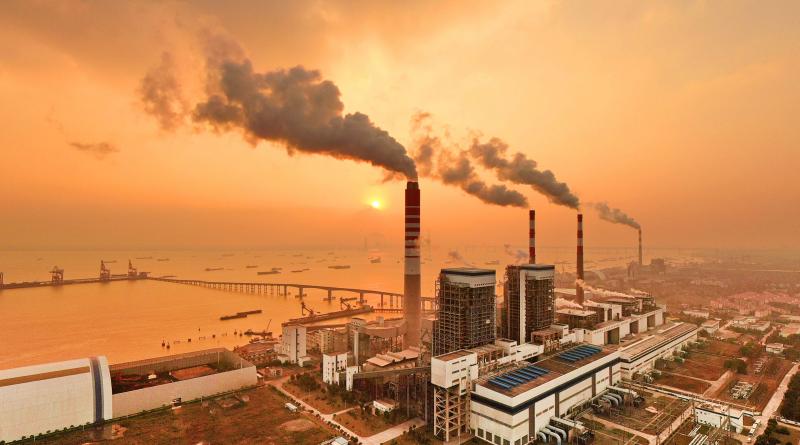Why China’s CO2 emissions grew less than feared in 2019.

With the novel coronavirus outbreak jamming the attention of news media and policymakers alike since mid-January, last year seems like a very long time ago.
On 28 February, however, the Chinese National Bureau of Statistics (NBS) released its annual “statistical communique” of preliminary data on the Chinese economy in 2019. This gives us a first picture, using full-year data, of how much Chinese CO2 emissions changed from 2018 to 2019, based on high-level energy consumption estimates, key industrial production data and several other data points.
The communique suggests Chinese CO2 emissions grew by less than 2% last year, depending on which numbers are used. This is much slower than the 4-5% suggested by monthly data as of mid-2019, and even as of December. It is also below, but broadly in line with projections in our Global Carbon Budget for 2019, published in December
In this guest post, we give a brief overview of what happened to Chinese energy consumption and emissions in 2019, as well as insight into why the monthly data suggested much higher emissions growth than the final full-year totals.
This has been a recurring issue, which we now adjust for, and the insight will be useful for understanding why Chinese energy statistics often look inconsistent – or even suspicious.
We also offer updated estimates of emissions growth in 2019, in other key countries and around the world, as well as reflecting on the prospects for the year ahead. Contrary to our December estimate of 0.6% growth, the update suggests that global CO2 emissions may have been flat in 2019.
Our key insights for China and the world include:
- China’s CO2 emissions grew by an estimated 1.7-2% in 2019, with demand for coal rising slowly (+0.7%) whereas oil (+6.8%), gas (8.6%) and cement (+4.9%) grew more quickly.
- The figures for coal and CO2 emissions are far lower than would have been expected, based on monthly data released throughout the year.
- Much of the discrepancy can be explained by differences in statistical coverage, missing data and other known factors, but some unexplained differences remain.
- Along with extra data from other countries, the full-year figures for China suggest global emissions grew by 0.1% in 2019, lower than the 0.6% estimate we published in December.
China’s energy and emissions in 2019
In broad terms, the statistical communique for 2019 suggests that economic growth was slumping in China last year, meaning growth rates of energy consumption and CO2 emissions followed suit.
Slowing growth for CO2 emissions was aided by the continued shift towards non-fossil sources of energy, as well as a mix of energy-efficiency improvements and economic restructuring away from heavy industry. For China to peak and then reduce its emissions, however, either growth in energy demand must slow even further, or clean energy sources must expand at a greater rate.
Overall, GDP (gross domestic product) was reported to have grown by 6.1% last year, as usual in line with government forecasts. This is, nevertheless, the lowest rate in three decades, amid widespread speculation that the real growth rate may have been even lower.
Within that total, service sectors grew by 6.9%, some 1.2 percentage points faster than industrial sectors at 5.7%. This reflects the ongoing gradual restructuring of the Chinese economy, although the gap was only half of what it has typically been in recent years.
The annual growth rates for fossil fuels, cement and CO2 implied by the communique are shown in the table, below left, alongside our early projections (right), which were published in December and based on monthly industrial production and customs data for the first nine months of the year. The differences between these two columns are discussed in detail below.
| Statistical Communique | Global Carbon Budget projection (with uncertainty) | |
|---|---|---|
| Coal | 0.7 % | 0.8% (-0.4% to +2.0%) |
| Oil | 6.8 % | 6.9% (+4.5% to +9.1%) |
| Natural gas | 8.6 % | 9.1% (+6.5% to +12%) |
| Cement | 4.9 % | 6.3% (+0.2% to +13%) |
| CO2 | 1.7 % | 2.6% (+0.7% to +4.4%) |
According to the communique, there was strong growth in demand for crude oil (+6.8%) and natural gas (+8.6%), while cement production grew by 4.9%. These numbers would be high growth for most mature economies, but are quite moderate for China.
(In fact, total oil consumption growth may have been even lower, perhaps as low as 4.4%, because of reduced imports and possibly growing inventories of refined oil products.)
The recent trend for slow growth in coal demand continued, rising by 1.0% measured in tonnes by weight – or just 0.7% in terms of energy content adjusted for net imports and stock changes.
The communique also reported figures for GDP and CO2 emissions per unit GDP, which together imply that CO2 emissions grew by 1.7%. It is not clear whether this number only includes fossil fuels or also includes cement production, which could bump the CO2 growth closer to 2.0%..
The changes in China’s fossil-fuel demand are shown in the chart, below, along with non-fossil energy from nuclear and renewables.
Energy consumption in China from 2000-2019, by fuel, in exajoules (EJ). Coal (black), oil (dark grey) and gas (light grey) are shown separately while non-fossil sources (blue) are grouped together. 2019 figures are estimates based on the statistical communique. The energy content of electricity from non-thermal energy sources such as hydropower, wind and solar is calculated as the average equivalent amount of energy needed to generate the same electricity using coal in China. This is a widely used convention in China. Source: China Statistical Yearbook 2019, Statistical Communique 2019. Chart by Carbon Brief using Highcharts.
The low growth in coal demand was at least in part due to a slowdown in coal-fired power generation, first reported by Carbon Brief last November. At this stage, the NBS only publishes data for all thermal sources together, including coal, oil, gas and biomass, of which coal accounted for 91% of the total in 2018, the last year with detailed data.
The aggregate measure for thermal generation grew by just 2.4% in 2019, but given faster recent growth for gas and biomass, the coal figure may have been much lower than this. About half of all coal in China goes to generating electricity, so weak growth there has a big impact on the total.
The remainder of Chinese coal demand comes largely from coal-intensive industries, such as cement, steel and non-ferrous metals. Here, production grew steadily, as shown in the chart below, but no one product or sector dominated the growth.
Annual growth in output from major coal-intensive products in China, 2000-2019. Preliminary figures for 2019 are marked in red. Source: China Statistical Yearbook 2018 (2000-2018 data) and the 2019 Statistical Communique (2019 data). Chart by Carbon Brief using Highcharts.
In other words, last year was a case of what the Chinese authorities would refer to as “quality over quantity” in economic growth, with long-term restructuring of the economy, the US trade war and structural issues probably all contributing to lower growth.
Misleading monthly data?
Readers of our articles on annual Chinese statistics from previous years will have noticed that inconsistencies and unexplained gaps in the statistics are a recurring theme, in particular for coal consumption and coal supply data.
Many will also have seen reports last July, based on monthly data, suggesting China was in the midst of rapid 3% growth for coal demand and 4% for CO2 emissions, relative to the same period in 2018. The much lower rates of growth during 2019 as a whole might, therefore, come as a surprise.
By September last year, the monthly data that forms the basis of our early projections showed even more rapid growth, of nearly 5% in the supply of coal, estimated as production plus net imports. Together with figures for oil, gas and cement, this would have implied 5-6% growth in CO2 emissions in 2019.
Even stranger, the monthly data for December, supposedly reflecting the whole year, were still 4.4% for coal and 5.0% for CO2. This is hard to square with the figures from the statistical communique, noted above, of 0.7% or 1.0% growth for coal and an implied 1.7% growth for CO2 emissions.
At least part of the gap can be explained by understanding the numbers the NBS publishes – and what lies behind them. For example, it does not publish any monthly consumption data for coal, oil or natural gas, so consumption estimates before the end of the year must be based on monthly data for production, imports and exports.
We will use coal as an example, because it is still by far the biggest energy source in China – and the one where the various data gaps have the largest impact on overall estimates of energy consumption and CO2 emissions.
If the data are 100% accurate, coal consumption should be equal to domestic coal production, plus net coal imports (imports minus exports), plus the net amount of coal taken from inventories (also called “stock changes”), minus any losses.
This sum is the coal supply, also called “apparent consumption”. In reality, the data are never complete or exact, losses are often poorly known and the methods used to collect different types of data may not be quite consistent. So there is a gap between the supply and consumption data, called “statistical differences”.
Usually, monthly data on production and imports/exports are the only data that are available from NBS before the end of the year, so mid-year estimates of coal consumption – including ours – often use supply as a proxy for consumption, and production plus net imports as a substitute for actual supply. In our projections, we simply leave out the stock changes, which are incompletely reported on a monthly basis, instead including them as part of the uncertainty margin.
The monthly data also has two main issues that are important to understand. First, the production data only include production by enterprises that have revenues above a certain limit (“above-limit” enterprises) that requires them to submit monthly reports to statistical agencies, typically 20m RMB per year (US$3m).
Second, the monthly production and import/export data only report the weight of the coal in tonnes, not how much energy it contains. This matters, because the energy content of different coal types can vary greatly and the amount of CO2 released when burning coal depends more on how much energy is released than on how much it weighs.

In the preliminary full-year data released in the statistical communique, the NBS reports estimates of actual consumption, in addition to production and import/exports. It also attempts to reflect all enterprises through sampling, not just the ones above the reporting limit.
For coal, it also usually reports coal’s share of total energy consumption, which makes it possible to calculate coal consumption growth measured by energy content. This information is not provided for oil or natural gas, but their energy contents vary much less than for coal, so it’s less of a problem.
Hence, the big sources of discrepancies between the monthly data before the end of the year and the annual data in the statistical communique the following February are:
- Lack of data for the last few months of the year, which obviously is an unavoidable source of uncertainty when using monthly data before the end of the year.
- Differences in statistical coverage, relating to the reporting limit for large enterprises.
- Stock changes, which are either completely lacking or only partially included in estimates based on monthly data.
- Statistical differences – in other words, discrepancies between supply and consumption data. These are the truly “unexplained” gaps.
- Changes in energy content per tonne, in the case of coal. No information on energy content is available in the monthly data, but can be calculated for coal using data in the statistical communique.
The relative contributions of each of these factors are shown in the charts, below, for the years between 2015 and 2019. In each chart, the leftmost column shows the early estimate based on monthly data up to September and the rightmost column shows the full-year figure.
Contributions to the gap in growth rates, %, between monthly coal supply data in September and full-year data on coal consumption, measured in energy content including all coal-based products. Red denotes contributions that reduce the absolute growth, bringing it closer to zero, while green denotes contributions that enhance growth. Data on stock changes are not available for 2018 and 2019, and have therefore been subsumed under statistical differences. Sources: China Energy Statistical Yearbook 2018 (for 2015-2017 data); Statistical Communique of the PRC 2018 and 2019 (for 2018 and 2019 data, respectively); Monthly statistical reports from the General Administration of Customs, PR China (for monthly import/export data). Chart by Carbon Brief using Highcharts.
The “unexplained differences” – in other words, statistical discrepancies – are clearly large, but in most years much of the gap between the early and annual estimates for coal demand growth can, in fact, be explained by understanding what the various pieces of data actually represent.
The striking feature here is that almost all components of the gap conspire to reduce the magnitude of the growth or reduction suggested by the monthly supply data, producing a growth rate closer to zero, which explains the difficulties of many earlier projections made using that data.
This, perhaps, should not be entirely unexpected. In years when inventories are high and able to supply much of the needed coal, there will be less demand for newly produced coal, so that production and stock changes are likely to be negatively correlated.
Similarly, in years when both coal demand and coal production grow quickly, there may be demand for lower quality coal with lower energy content to plug the gaps, and vice-versa, in years with lower demand, so production and changes in energy content may also pull in opposite directions.
Adjusting for the gap
Above all, the differences create a gap between “naive” estimates of energy demand and emissions growth, based on monthly supply data alone, versus the annual data published in the February communique.
In addition, the data in the communique is only preliminary and is usually revised somewhat, before final statistics are published up to two years later. The size of the gap and its individual parts can, of course, not be known ahead of time, but at least in recent years they have been systematic enough that they can be adjusted for, in order to make better projections before the year has finished.
This is what we did this year in our projection of fossil-fuel consumption and CO2 emissions in the Global Carbon Budget for 2019. We calculated a “naïve” growth rate for each fossil fuel and cement by using just the monthly production and import/export data up to September 2019.
Then, we compared historical final, annual data since 2014 with the monthly data up to September for the same years, before applying a “Bayesian” regression algorithm to calculate how much the naïve monthly estimates should be adjusted to best match the annual data, as well as an uncertainty range.
We only used data from 2014 onwards, because the structure of coal consumption, imports and stock changes after that year have been quite different from earlier years, and this corresponds to a marked shift in both policy and the structure of economic growth in China.
The gaps in those earlier years may, therefore, not be very representative of the present. The small number of years used results in a relatively wide uncertainty margin, but the adjustment still appears to give an improvement over projections we have made in previous years.
Still, this highlights an important caveat with our projection in the annual Global Carbon Budget: it takes a selected portion of the past as a guide for the future. If Chinese coal supply and the structure of the Chinese economy undergo sudden changes in the future, the adjustments we make to the monthly data may no longer be appropriate, and the projections will once again be off.

Further issues with the data
Here, we have only described the issues with the monthly data compared to the preliminary annual data in the statistical communique, looking at why the gap between them in recent years has created a few “pleasant surprises”, when growth in coal consumption and emissions turned out to be lower than one could have feared based on monthly data. But that is not to say that the data in the statistical communique is perfect or the final answer.
We will not bother readers here with rehashing the many issues with the statistical communique data and even the revised “final” data, except to reiterate that the data in the statistical communique are still preliminary and usually revised when “final” statistics are published up to two years later. Even these final figures may be revised considerably again in China’s five-yearly national economic censuses. See our earlier posts and a related paper for plenty more detail on all this.
Also, as alluded to previously, the growth number for oil in the statistical communique does not reflect imports or inventories of refined oil products, such as gasoline, diesel and numerous chemical feedstocks. It only reflects consumption of crude oil (and of refined products) produced from crude oil at domestic refineries.
This is not usually a big issue, but may be a factor this year because of a big drop in imports and – possibly – a big increase in inventories of refined products. See a previously mentioned Twitter thread for more on this, and a similar issue for coal versus coke and other coal products.
Updates on global emission estimates
In the Global Carbon Budget we also made projections for global emissions in 2019, as well as regional projections for India, the US and the EU28. These projections use slightly different methodologies in each case, due to large differences in data availability.
The table below shows how those projections have fared, after updating them with the latest available data, which is still not final. Many elements were not too far off and well within the original uncertainty ranges, but for the most part growth turned out somewhat lower than we expected.
| World | China | EU28 | USA | |||||
|---|---|---|---|---|---|---|---|---|
| Projection Nov 2019 | Revision Mar 2020 | Projection Nov 2019 | Revision Mar 2020 | Projection 2019 | Revision Mar 2020 | Global Carbon Budget projection | Revised estimate March 2020 | |
| Coal | -0.9% (-2.0% to 0.2%) | -1.9 % | 0.8% (-0.4% to +2.0%) | 0.7 % | -10.0% (-12.5% to -7.5%) | -18.4 % | -10.5% (-15.8% to -5.2%) | -13.2 % |
| Oil | 0.9% (0.3% to 1.6%) | 0.6 % | 6.9% (+4.5% to +9.1%) | 4.4 % | 0.5% (-1.0% to 2.0%) | -0.1 % | -0.5% (-1.6% to 0.6%) | -0.6 % |
| Natural gas | 2.6% (1.3% to 3.9%) | 2.7 % | 9.1% (+6.5% to +12%) | 8.6 % | 3.0% (1.5% to 4.5%) | 3.9 % | 3.5% (1.0% to 6.0) | 3.7 % |
| Cement | 3.7% (0.4% to 7.3%) | 3.2 % | 6.3% (+0.2% to +13%) | 4.9 % | 0.0% (-1.5% to 1.5%) | -0.4 % | 0.7% (-1.3% to 2.7%) | 2.4 % |
| CO2 | 0.6% (-0.2% to 1.5%) | 0.1 % | 2.6% (+0.7% to +4.4%) | 2.0 % | -1.7% (-3.4% to 0.1%) | -3.9 % | -1.7% (-3.7% to 0.3%) |
What stands out is a significant drop in coal consumption in the EU and US, both in the original projection and even more so in the updated figures. The main factors here are likely to have been increased CO2 prices in the EU Emission Trading System (EUETS), as well as aging coal power plants being outcompeted by natural gas and renewables in the US.
These drops, along with the low growth in China and India, are reflected in an unusually large drop in global coal consumption for all uses of almost 2%, double the reduction in our early estimate.
As a result, and contrary to our early estimate of a 0.6% increase, we now estimate that global emissions grew as little as 0.1% in 2019, with 0% well within the range of uncertainty. This aligns with estimates published by the International Energy Agency (IEA) in February this year.
Conclusions and outlook
In each of the past two years, our posts on Chinese statistics have focused on how coal demand and CO2 emissions have been rising again, after a slump from 2014 until 2016. We have also reflected on how the growth has been more moderate than expected from monthly data, until now without giving a thorough explanation for why.
Finally, we have offered our best guesses for whether the growth is a short-term blip or will continue well into the coming decade.
Each year, we have said that it will probably come down to whether the central and provincial governments in China will dare to take the steps necessary to rein in pollution and excess credit growth, even amidst slowing economic growth. Or if, instead, China will stick to the old playbook of propping up economic growth, through even more credit expansion and more investment in heavy industry, infrastructure and housing construction.
The same is true this year, further complicated by an ongoing trade war punctuated by a “Phase 1” agreement with uncertain prospects. Even if we knew what the eventual economic impact of the trade war would be, it would still be hard to say whether it would cause emissions to go down because of reduced economic activity, or whether they would go up because of more government stimulus and less attention given to cutting emissions.
In terms of the prospects for energy and emissions growth this year and beyond, however, the elephant in the room is, of course, the coronavirus epidemic.
In the short run, the quarantine of entire megacities, a several weeks-long near-shutdown of many sectors, severe travel restrictions and a still-deepening slump in investor confidence globally will most likely depress both economic growth and CO2 emissions considerably this year.
Industry data to date suggests that CO2 emissions in the four weeks after the end of China’s lunar new year holiday were around 25% lower than the same period in 2019.
But just as with the trade war, we do not know what will happen in the longer term. A worsening or slow recovery from the epidemic might cause emissions to rebound only slightly, and to stay lower for the rest of 2020.
On the other hand, continued improvements in the energy mix and economic structure might keep emissions on a longer-term downward trend. But just as likely, attempts to kick-start the economy might result in as high or even higher emissions in 2021 and beyond.
So, the future is as unpredictable as ever. But, at least this year, there is hope that we will not be fooled by high apparent growth in coal and emissions in the mid-year statistics.
*Read the original article here
9 March 2020
Carbon Brief



